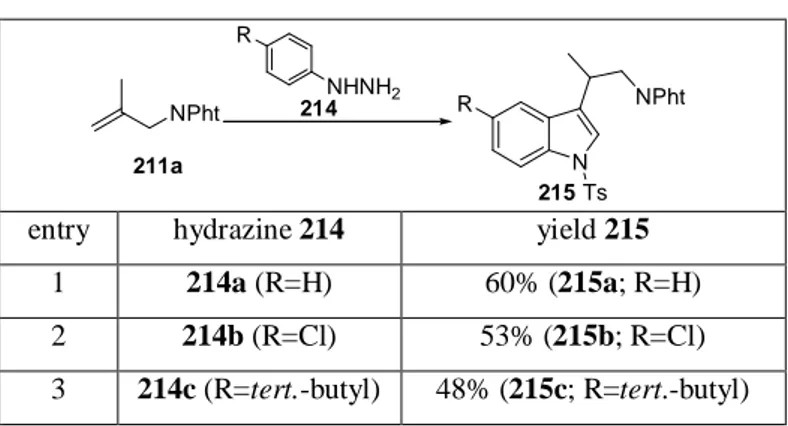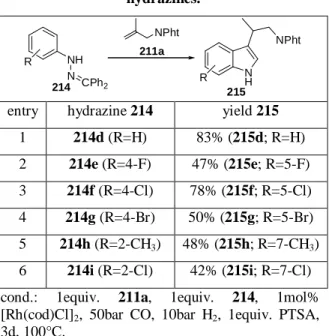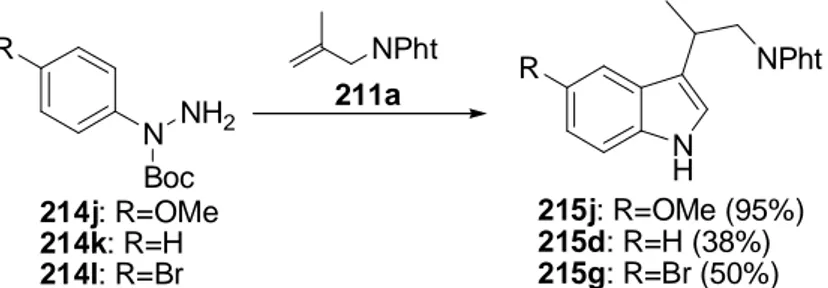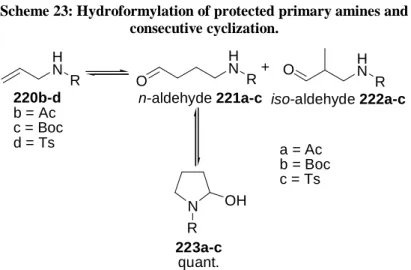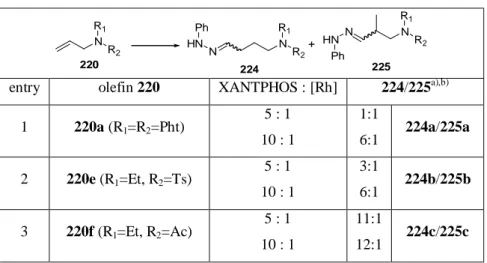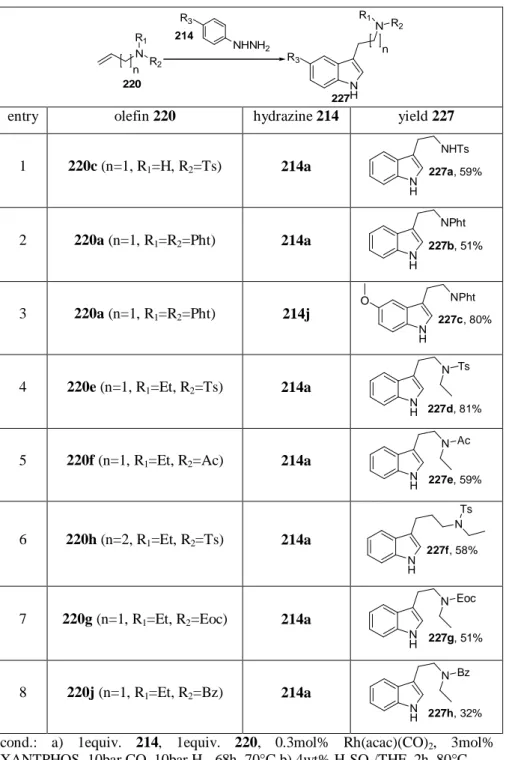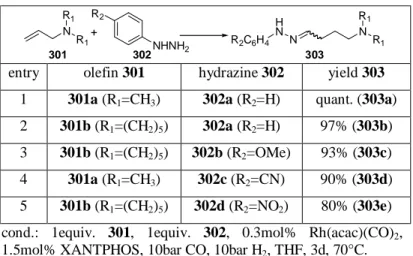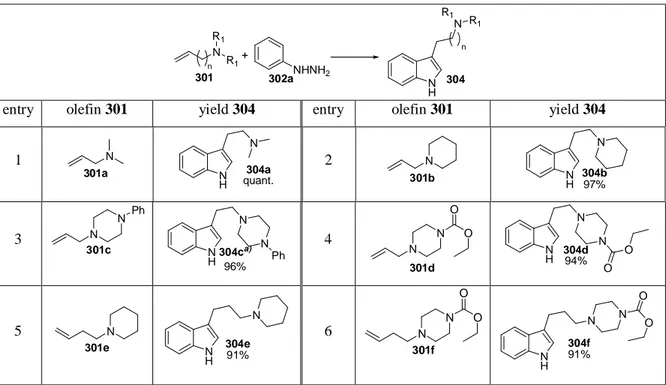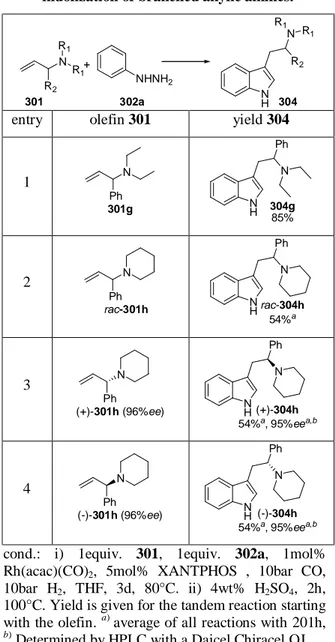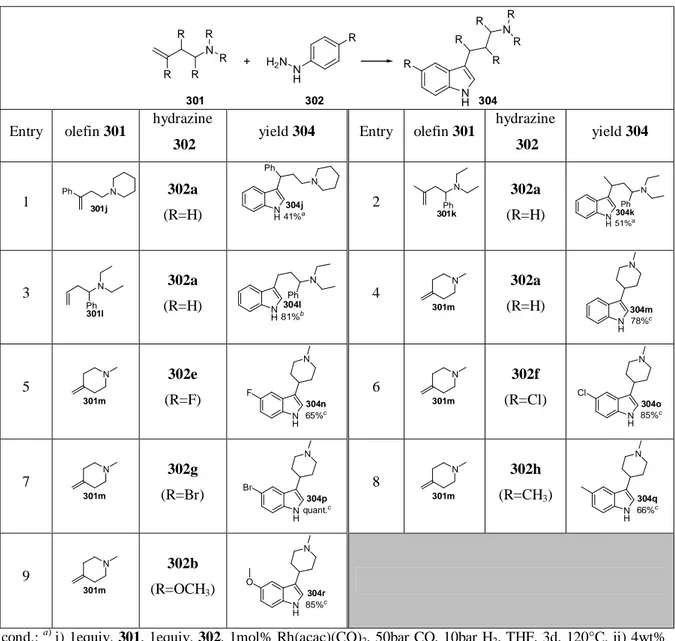Tandem Hydroformylation / Fischer Indolization
– Synthesis of Biologically Relevant Indoles under Hydroformylation Conditions –
Dissertation zur
Erlangung des akademischen Grades eines Doktors der Naturwissenschaften
(Dr. rer. nat.)
des Fachbereichs Chemie der Universität Dortmund
vorgelegt von Axel Matthias Schmidt
aus Iserlohn
Dortmund, 2005
1. Gutachter: Prof. Dr. P. Eilbracht
2. Gutachter: Prof. Dr. H. Waldmann
Tag der mündlichen Prüfung: 17. Oktober. 2005
I gratefully thank the following persons:
Prof. Dr. P. Eilbracht for the chance to work in his research group, the interesting research topic, his support in many situations and the trust in my skills
Prof. Dr. H. Waldmann for agreeing to act as a co-referee to this thesis Prof. Dr. P. Eilbracht, PD Dr. B. Plietker,
PD Dr. B. Schmidt, Dr. G. Angelovski,
Dr. F. Koç, Dr. A. Schmidt, Dr. K. Müller for many discussions, suggestions and ideas Dr. G. Angelovski for his cooperation with “Macrocyclic
Bishydrazones as Metal Sensors”
PD Dr. R. Breinbauer, M. Mentel for their wonderful cooperation with “Tandem Hydroformylation / Fischer Indolization on Solid Phase”
Ms. P. Linnepe (fka: Köhling) for letting me play in her playground Prof. Dr. Costisella, Ms. Danzmann,
Ms. Marzian, Ms. Vornweg, Ms. Eichhorn, Mr. Hüfner, Mr. Urschel, Mr. Köpke,
Ms, A. Bokelmann, Mr. Lausecker. for collecting analytical data Ms. A. Biernat, Ms. N. Bisek, Mr. K. Fischer,
Mr. J. Liebich and Mr. N.M. Neisius (I really appreciated your support and without your commitment I would not be able to present
many results.) for supporting me as a lab student Ms. A. Schick and Mr. O. Gerbersmann for supporting me as research apprentices
Ms. R. Lawniczek for supporting me as a trainee lab assistant Ms. S. Lessing, Ms. S. Kuhl, Dr. Albert,
Dr. Hillgärtner for administrative support Ms. M. Rak for proof-reading this thesis
My lovely girlfriend Ariane for sweetening my life in the past 18 months.
(I’m looking forward to the following years!)
„The Rosis“ for supporting me in difficult situations and
letting me be part of their family
In memoriam:
H EIDI S CHMIDT († 2003)
H ANS -W ERNER S CHMIDT († 1995)
To my brother for his courage and his never ending support
The following work has been done in the period from August 2001 until July 2005 at the Faculty of Chemistry, University of Dortmund, under the supervision of Prof. Dr. Peter Eilbracht.
Abbreviations in this thesis are used according to the recommendations of IUPAC and IUBMB. They are defined at their first appearance in the text, except common abbreviations such NMR, HPLC or THF.
The results presented in this thesis are already published or will be published as follows:
Ø Chapter 2 “Synthesis of Primary and Secondary Tryptamines”
• Köhling, P.; Schmidt, A.M.; Eilbracht, P.; Org. Lett . 2003, 5, 3213-3216.
• Schmidt A.M.; Eilbracht, P.; Org. Biomol. Chem. 2005, 3, 2333-2343.
Ø Chapter 3:”Synthesis of Tertiary Tryptamines”
• Schmidt, A.M.; Eilbracht, P.; J. Org. Chem. 2005, 70, 5528-5535.
• Köhling, P.; Schmidt, A.M.; Eilbracht, P.; Org. Biomol. Chem. 2005, in preparation.
Ø Chapter 4:”Functionalization of Tryptamines under Hydroformylation Conditions”
• Schmidt, A.M.; Eilbracht, P.; Adv. Synth. Catal. 2005, in preparation.
Ø Chapter 6:”Synthesis of Macrocyclic Bishydrazones and Their Application as Metal Sensors”
• Schmidt, A.M.; Angelovski, G.; Eilbracht, P.; 2005, in preparation.
Ø Chapter 8:”Tandem Hydroformylation / Fischer Indole Synthesis on Solid Phase”
• Mentel, M; Schmidt, A.M.; Breinbauer, R.; Eilbracht, P.; 2005, in preparation.
Acknowledgement...5
General Comments... 11
Table of Contents ... 13
1 Introduction and Aims of the Project ... 17
1.1 Relevance of Indoles and their Synthesis... 17
1.2 Hydroformylation ... 20
1.3 Hydroformylation and Indole Synthesis ...22
1.4 Aim of the Project... 24
2 Synthesis of Primary and Secondary Tryptamines... 26
2.1 Hydroformylation in the Presence of Hydrazines ... 26
2.2 Indolization of Aryl Hydrazones ... 29
2.3 Different Sources of Aryl Hydrazines ... 30
2.3.1 Commercially Available Aryl Hydrazines ... 30
2.3.2 Benzhydrylidene Protected Aryl Hydrazines ... 31
2.3.3 α -Boc Protected Aryl Hydrazines... 32
2.4 Stability of Nitrogen Protecting Groups ...33
2.5 Applications of the Hydroformylation / Fischer Indolization ... 34
2.6 n-Selective Tandem Hydroformylation / Fischer Indolization... 35
2.6.1 n-Selective Hydroformylation of Allylic Amides... 35
2.6.2 Influence of Aryl Hydrazines on n-Selective Hydroformylation ...37
2.6.3 Application of n-Selective Hydroformylation / Indolization ... 38
2.7 Interim Conclusion ... 40
3 Synthesis of Tertiary Tryptamines ... 41
3.1 Hydroformylation in the Presence of Aryl Hydrazines ... 42
3.2 Fischer Indolization ... 43
3.2.1 Tryptamines with Linear Side Chains ... 43
3.2.2 Tryptamines with Branched Side Chains ... 44
3.2.3 Indolization under Rearrangement... 47
3.2.4 Homotryptamines with Branched Side Chains ...48
3.3 Tandem Reaction in Water...49
3.4 Application – Synthesis of Migraine Drugs ...52
3.5 Interim Conclusion ...53
4 Functionalization of Tryptamines under Hydroformylation Conditions ...55
4.2 Functionalization of 3-Piperidyl Indoles via Hydroaminomethylation ... 59
4.3 Interim Conclusion ... 63
5 Intramolecular Tandem Hydroformylation / Fischer Indolization ... 64
5.1 Intramolecular Condensation and Indolization ...66
5.2 Intermolecular Condensation and Intramolecular Indolization...70
5.3 Interim Conclusion ... 74
6 Synthesis of Macrocyclic Bishydrazones and Their Application as Metal Sensors ... 75
6.1 Interim Conclusion ... 82
7 Initial Investigations towards Asymmetric Tandem Hydroformylation / Fischer Indole Synthesis ... 83
7.1 Synthesis of a Test Substrate via Overman Rearrangement ... 86
7.2 Synthesis of a Test Substrate via Allylic Amination ...87
7.3 Stereoselective Hydroformylation / Fischer Indolization ... 91
7.4 Interim Conclusion ... 93
8 Tandem Hydroformylation / Fischer Indole Synthesis on Solid Phase... 94
8.1 Hydroformylation on Solid Phase ... 96
8.2 Fischer Indole Syntheses on Solid Phase ... 98
8.3 Hydroformylation of Sulfonamide Linked Aminoolefins... 101
8.4 Tandem Hydroformylation / Hydrazone Formation of Sulfonamide Linked Aminoolefins... 104
8.5 Tandem Hydroformylation / Fischer Indolization of Sulfonamide Linked Aminoolefins... 106
8.5.1 First Generation Protocol ... 106
8.5.2 Second Generation Protocol ... 107
8.6 Interim Conclusion ... 108
9 Summary and Outlook... 110
9.1 Summary ... 110
9.2 Outlook... 116
10 Experimental Section... 122
10.1 Materials... 122
10.2 General Methods... 123
10.3 Experiments in Chapter 2... 123
10.3.1 General Procedure for the Hydroformylation... 123
... 125
10.3.3 General Procedure for the Tandem Hydroformylation / Fischer Indole Synthesis Followed by Tosylation of the Crude Product ... 127
10.3.4 General Procedure for the Tandem Hydroformylation / Fischer Indole Synthesis Using Benzhydrylidene Protected Aryl Hydrazines... 129
10.3.5 General Procedure for the Tandem Hydroformylation / Fischer Iindole Synthesis with Subsequent Addition of Acid ... 131
10.3.6 General Procedure for the Regioselective Tandem Hydroformylation / Fischer Indole Synthesis ... 134
10.4 Experiments in Chapter 3... 138
10.4.1 Synthesis of Aminoolefines ... 138
10.4.2 Tandem Hydroformylation / Hydrazone Formation ... 142
10.4.3 First Generation Protocol of Tandem Hydroformylation / Fischer Indole Synthesis ... 144
10.4.4 Second Generation Protocol for the Tandem Hydroformylation / Fischer Indole Synthesis in Water... 152
10.4.5 Synthesis of LY 349 950 & 334 370... 154
10.4.6 Synthesis of L 775 606... 155
10.5 Experiments in Chapter 4... 158
10.5.1 Synthesis of 401b ... 158
10.5.2 Synthesis of 402 ... 159
10.5.3 Synthesis of 403 ... 161
10.5.4 Synthesis of 404 ... 161
10.6 Experiments in Chapter 5... 163
10.7 Experiments in Chapter 6... 172
10.8 Experiments in Chapter 7... 172
10.9 Experiments in Chapter 8... 175
10.9.1 Hydroformylation on Polymer Support... 175
10.9.2 Tandem Hydroformylation / Hydrazone Formation on Polymer Support. .... 176
10.9.3 Tandem Hydroformylation / Fischer Indolization on Polymer Support ... 177
Zusammenfassung... 179
1 I NTRODUCTION AND A IMS OF THE P ROJECT
1.1 R ELEVANCE OF I NDOLES AND THEIR S YNTHESIS
Tryptamines are involved in various different biological processes. Serotonin for example, is a neurotransmitter and influences the human nervous system. It controls the state of mind, affects the circadian rhythm, sexual urge and body temperature and seems to play a key role in neurological disorders like migraines. Tailored serotonin type tryptamines are therapeutically used to influence these systems by addressing the responsible receptors selectively. Recent contributions in migraine drug development clearly demonstrate that not only extended substituents in 5-position are required to achieve high selectivities towards subtypes of the serotonin receptor family, but also sophisticated amine moieties in the 3-position as well as a defined distance by which this amine is attached to the indole core (Scheme 1)
1.
Scheme 1: Recent developments in migraine therapy
2.
N H
N H
5 3
N H H N
O
N
F O
2S N
N N
F N
N N
LY 334 370 Eletriptan
L 775 606
From a synthetic chemist’s point of view these and additional features of indole type pharmaceuticals are interesting, such as the occurrence of branching in the α- and β-positions with respect to the indole core, or stereochemical issues as well as the fact that the side chain nitrogen might be embedded in a cyclic system such as piperidines, pyrrolidines or
1
For reviews on migraine therapy see: a) Schaible, H.-G.; Ebersberger, A.; PharmIUZ 2002, 31, 452-457. b) Limmroth, V.; PharmIUZ 2002, 31, 458-461. c) Gurrath, M.; PharmIUZ 2002, 31, 470-478. Link, A.; Link, B.;
PharmIUZ 2002, 31, 486-493.
2
a) Johnson, K.W.; Schaus, J.M.; Durkin, M.M.; Audia, J.E.; Kaldor, S.W.; Flaugh, M.E.; Adham, N.;
Zgombick, J.M.; Cohen, M.L.; Branchek, T.A.; Phebus, L.A.; NeuroReport 1997, 8, 2237-2240. b) Harding, V.
D.; Macrae, R.J.; Ogilvie, R.J.; PCT Int. Appl. 1996, WO9606842A1. c) MacLeod, A.M.; Street, L. J.; Reeve, A.J.; Jelley, R.A.; Sternfeld, F.; Beer, M.S.; Stanton, J.A.; Watt, A.P.; Rathbone, D.; Matassa, V.G.; J. Med.
Chem. 1997, 22, 3501-3503.
piperazines. All these features demand synthetic strategies which give convenient and fast access to highly diverse libraries of tryptamines and their homologues. Therefore, it would be preferable to have a general protocol allowing the synthesis of these compounds with simultaneous variations in all important positions. A modular approach with high diversity desires fusion of all building blocks in a late synthetic step with flexible determination of the chain length and the substitution pattern in the side chain. Such a convergent strategy should preferably include the construction of the indole core, with all necessary building blocks (amine moiety, side chain fragment, properly substituted aromatic indole precursor) being easily available in large amounts in prior synthetic steps (Scheme 2).
Scheme 2: Modular approach to tryptamines.
NH
R R
R
2N amine moiety side chain
fragment aromatic indole
precursor n
R
F ISCHER ’s and the L AROCK ’s method are the most common for the preparation of indoles. In L AROCK ’s indole synthesis o-halo anilines are connected with a functionalized alkyne under palladium catalysis
3(Scheme 3).
Scheme 3: Basic principle of the Larock indole synthesis.
NH
2I R
R
N H R
R [Pd
0] R
R
Synthesis of additionally substituted o-halo anilines, however, requires further steps and is not always easily achieved. Similarly the alkyne unit may require laborious synthetic procedures. If the final product bears additional substituents on the six-membered ring of the indole core, the substituted o-halo anilines subjected to the L AROCK synthesis can cause steric hindrance. Similarly, obtaining the starting materials for F ISCHER ’s indole synthesis can be
3
a) Larock, R.C.; Yum, E.K. J. Am. Chem. Soc. 1991, 113, 6689. b) Larock, R.C.; Yum, E.K.; Refvik, M.D. J.
Org. Chem. 1998, 63, 7652.
laborious. Here, carbonyl compounds are reacted with aryl hydrazines under acid catalysis
4(Scheme 4).
Scheme 4: Basic principle of The Fischer indole synthesis.
N H NH
2R O R
N H R
R acid
While a number of different approaches have been reported for the synthesis of substituted aryl hydrazines (the degree of substitution is reduced by one as compared to the aryl halide required for a L AROCK synthesis of the same compound), synthesis of the carbonyl compound very often requires a large number of simple functional group transformations (e.g.
homologization of the carbon chain, reduction, oxidation). If aldehydes are needed for the indolization step, these have to be protected as acetals, aminals, enol ethers or bisulfite adducts in order to prevent aldol condensation and oligomerization under the harsh conditions of the F ISCHER indole synthesis. In some cases the use of masked carbonyl compounds like in the J APP -K LINGEMANN modification is useful. Here β-ketoesters are reacted with aryl diazonium salts to give aryl hydrazones after cleavage of acetic acid. The same hydrazone can be obtained upon condensation of the corresponding α-keto ester with aromatic hydrazines.
Scheme 5: Use of Ketoesters as masked aldehydes in indole syntheses.
N H N
COOR R COOR
R
O N
2+X
-N H
COOR R
N H R Japp-Klingemann
-CH
3COOH
Fischer indolization
H
2O/H
+-HOR, CO
2O
COOR R N H
NH
2-H
2O
4
a) Robinson, B.; Chem. Rev. 1963, 3, 373. b) Ishii, H.; Acc. Chem. Res. 1981, 14, 233-247. c) Robinson, B.;
“The Fischer Indole Synthesis”; Wiley, New York, 1982. d) Hughes, D. L.; Org. Prep. Proced. Int. 1993, 25,
607-632. e) Gribble, G. W.; J. Chem. Soc., Perkin Trans. 1 2000, 1045.
F ISCHER indolization of this hydrazone gives the indole-2-carboxylic acid ester which decarboxylates after hydrolysis, giving indoles without a substituent at the 2-position
5. In summary, both, the α-keto ester as well as the β-ketoester, serve as masked aldehydes (Scheme 5). These methodologies require additional steps and reagents and may hamper a general application with broad diversity as demanded for an ideal synthesis
6and the medicinal chemist’s needs.
1.2 H YDROFORMYLATION
A chain elongating in situ synthesis of aldehydes might be an alternative to the above described methods. The hydroformylation of olefins is a well known and reliable method for the synthesis of aldehydes and has been used in industrial processes
7. But although the aldehyde functionality offers a wide range of further transformations, only a few examples are reported in which hydroformylation is used in a multi-step synthesis of fine chemicals.
Obviously the homologization of the carbon skeleton by one carbon atom is not efficient enough and is only useful for simple steps at the very beginning of a synthesis. If the hydroformylation could be combined with methodologies for the derivatization of the aldehyde group to one step, the hydroformylation may become an even more attractive tool in the synthesis of fine chemicals.
In the past few decades, a number of so called tandem reactions or reaction sequences under hydroformylation conditions have been reported
8. The hydroformylation of terminal diarylethenes in the presence of primary and secondary amines affords direct access to pharmacologically active 3,3-diarylpropylamines. This tandem reaction consists of hydroformylation and reductive amination. Rhodium catalyzes the hydroformylation of the olefin as well as the hydrogenation of the enamine which results from the condensation of the aldehyde with the secondary amine (Scheme 6)
9.
5
For recent examples see: Heinrich, T.; Böttcher, H.; Gericke, R.; Bartoszyk, G.D.; Anzali, S.; Seyfried, C.A.;
Greiner, H.E.; van Amsterdam, C.; J. Med. Chem. 2004, 47, 4684-4692.
6
Wender, P.A.; Handy, S.T.; Wright, D.L.; Chemistry & Industry 1997, 765-769.
7
Beller, M.; Cornils, B.; Frohning, C. D.; Kohlpaintner, C. W.; J. Mol. Catal. A 1995, 104, 17.
8
a) Eilbracht, P; Bärfacker, L.; Buss, C.; Hollmann, C.; Kitsos-Rzychon, B. E.; Kranemann, C. L.; Rische, T.;
Roggenbuck, R.; Schmidt, A.; Chem. Rev. 1999, 99, 3329-3366. b) Schmidt, A.M.; Eilbracht, P; in Transition Metals for Organic Synthesis: Building Blocks and Fine Chemicals; (Beller, M.; Bolm, C.), 2
nded., Wiley-VCH, Weinheim, 2004, 57-111. c) Schmidt, A.M.; Eilbracht, P.; in Topics in Organometallic Chemistry; (Beller, M.), Springer Verlag, New York, 2005, in preparation.
9
Rische, T.; Eilbracht, P.; Tetrahedron 1999, 55, 1915-1920.
Scheme 6: Hydroaminomethylation in the synthesis of pharmaceuticals.
Ph Ph
Ph Ph
Ph Ph
Ph Ph O
N N N H
hydroformylation
condensation
hydrogenation hydroaminomethylation
Diisopromine (spasmolytic/choleretic) 76%
Among all tandem hydroformylation sequences, methods in which the aldehyde functionality is used for the formation of additional C-C-bonds seem to be the most attractive.
The tandem enolboration / hydroformylation / aldol addition may act as a good example.
Here, hydroformylation of an unsaturated carbonyl compound is combined with an aldol reaction. The boron enolate is generated in a previous step from the unsaturated carbonyl, a boron halide and triethylamine. This boron enolate is hydroformylated selectively at the terminal double bond. The resulting aldehyde undergoes an aldol reaction with the boron enolate in situ with transfer of the boron enolate’s configuration to the aldol product, resulting in good to excellent diastereoselectivities (Scheme 7).
Scheme 7: Tandem enolboration/hydroformylation/aldol reaction.
O O
OH
COOEt
COOEt OH
86%, dr 20:1
82%, only cis tandem enolboration/
hydroformylation/ aldol reaction
tandem hydroformylation/
enolboration/ aldol reaction
Very recently this methodology has been used for a diastereoselective synthesis of the A-ring of forskolin (Scheme 8)
10.
10
Keränen M.D.; Eilbracht P.; Org. Biomol. Chem. 2004, 2, 1688-1690.
Scheme 8: Synthesis of the A-ring of forskolin via tandem enolboration/hydroformylation/aldol reaction.
O
COOEt OH
COOEt O
O HO O
OH OH
OAc Forskolin enolboration/ A
hydroformylation/
aldol addition
82%, 2.5:1dr
1.3 H YDROFORMYLATION AND I NDOLE S YNTHESIS
Surprisingly, only few examples are described in which the hydroformylation has been used to generate aldehydes required for indole syntheses. Thus, hydroformylation of styrene type anilines, derived from a H ECK reaction of o-halo anilines, gives tryptamines in fair yields.
Here, the olefinic bond is regioselectively hydroformylated, and the resulting aldehyde condenses intramolecularly with the amine to give 3-substituted indoles (Scheme 9)
11.
Scheme 9: Tandem hydroformylation/enamine formation in the synthesis of tryptamines CO/H
2(1:1), 21 bar
HRh(CO)(PPh
3)
3/PPh
3toluene, 70h, 70°C
32-73%
X NH
2R R NH
2R'
N H
R'
R [Pd]
X = Br, I
R = Hal, OMe, CH
3, CF
3R' = N(Boc)
2,OH, NHTs
o-Nitrostyrenes can also be converted with this method, as the nitro group is reduced under hydroformylation conditions
12. This approach is then comparable with the indole syntheses of R EISSERT
13, S UGASAWA
14and B ATCHO and L EIMGRUBER
15.
More recently S ELWOOD et al. have used the hydroformylation for the synthesis of migraine drug 4991W93 to control the relative configuration of the final product, albeit with poor regioselectivity (Scheme 10)
16.
11
Dong, Y.; Busacca, C. A.; J. Org. Chem. 1997, 62, 6464-6465.
12
Ucciani, E.; Bonfand, A.; Chem. Commun. 1981, 82.
13
Cannon, J. G.; J. Med. Chem., 1981, 24, 238.
14
Douglas, A.W.; Tetrahedron Letters 1994, 35, 6807.
15
Siu, J.; Baxendale, I.R.; Ley, S.V.; Org. Biomol. Chem. 2004, 2, 160-167.
16
Jandu, K.S; Barrett, V.; Brockwell, M.; Cambridge, D.; Farrant, D.R.; Foster, C.; Giles, H.; Glen, R.C.; Hill, A.P.; Hobbs, H.; Honey, A.; Martin, G.R.; Salmon, J.; Smith, D.; Wollard, P.; Selwood, D.L.; J. Med. Chem.
2001, 44, 681-693.
Scheme 10: Hydroformylation in indole syntheses: Control of relative configuration.
CN CN
O N
H N
N N
N
hydroformylation
4991W93
S HELDON et al. have published the synthesis of melatonin via regioselective hydroformylation of N-allyl acetamide followed by F ISCHER indole synthesis (Scheme 11)
17.
Scheme 11: Synthesis of melatonin via hydroformylation followed by Fischer indole synthesis.
NHAc NHAc
O
N H
NHAc MeO
MeO
NHNH
3Cl CO/H
2(1:1), 10bar
[Rh] /xanthphos toluene/H
2O
70°C, 10h 96 % acetic acid
44 %
In 2001, K ÖHLING was able to demonstrate that, both, the hydroformylation and the F ISCHER
indolization can be combined to a new tandem reaction
18. While the chain elongating hydroformylation is used to synthesize the aldehyde in situ from an olefin, reducing functional group transformations to a minimum, the presence of an aryl hydrazine and a B RØNSTED acid allows direct conversion to the indole.
Scheme 12: Basic principle of the tandem hydroformylation / Fischer indole synthesis.
N H R R R R
R R
O
R R
N N H CO/H
2/[Rh]
CO/H
2/[Rh]/[H
+] phenylhydrazine - H
2O / - NH
3[H
+] - NH
3phenylhydrazine - H
2O 101
102 103
104
17
Verspui, G.; Elbertse, G.; Sheldon, F. A.; Hacking, M. A. P. J.; Sheldon, R. A.; Chem. Commun. 2000, 1363.
18
Köhling, P.; Diploma Thesis 2001, University of Dortmund.
Thus, this tandem reaction includes three steps: hydroformylation of an olefin 101, condensation of aldehyde 102 with an aryl hydrazine to an aryl hydrazone 103 and finally B RØNSTED acid mediated [3,3]-sigmatropic Diaza-C OPE rearrangement and cyclization to indole 104 (Scheme 12). The fact that aldehydes as well as hydrazones are intermediates in this tandem reaction and do not have to be isolated clearly saves time and resources. A series of simple indole derivatives, including tryptophols and tryptamines, have been synthesized with this innovative methodology, starting from easily available olefins and phenylhydrazine (Scheme 13). However, yields need to be improved for more complex structures.
Scheme 13: First examples of tandem hydroformylation / Fischer indole synthesis.
N H N
H Ph Ph
N H
OEt
N H
6
NPht
25% 50%
18% 55%
1.4 A IM OF THE P ROJECT
Encouraged by these initial results the scope and limitations of this new tandem reaction should be clarified. While tryptophols, 2,3-disubstituted indoles and bisindoles will be discussed in a parallel work
19, this work shall concentrate on the following topics:
Ø Improvement of the existing protocol in order to
Ø develop a modular approach towards biologically and pharmaceutically relevant tryptamines and homologues under
Ø consideration of all necessary biological valances (i.e. substitution pattern at the indole core, type of amine moiety, length of side chain in 3-position, substituents in the side chain).
Ø Application towards recent drug candidates and
Ø synthesis of substance libraries for biological evaluations.
In this context
Ø the tandem reaction and its singular steps shall be investigated intensively starting with basic model aminoolefins with respect to
• stability of nitrogen protecting groups and
19
Köhling, P.; Dissertation 2005, University of Dortmund.
• different sources of aryl hydrazines.
Ø Furthermore, the tandem reaction shall be optimized with respect to
• chemoselectivity of the tandem reaction,
• regioselectivity of the hydroformylation and of the indolization and
• stereoselectivity of the hydroformylation.
Ø These optimized conditions shall be applied towards more complex substrates such as highly functionalized tryptamine derivatives of pharmacological relevance.
Ø The tandem reaction shall be transferred from solution to solid phase to allow
automated, combinatorial access to substance libraries.
2 S YNTHESIS OF P RIMARY AND S ECONDARY T RYPTAMINES
To achieve high chemoselectivities for the overall tandem process, it is important that all individual steps work as selectively as possible and all reagents and reactants required as well as all intermediates are compatible and do not affect each other. To ensure this, investigations are started with optimizations of each step, i.e. hydroformylation of aminoolefins, hydroformylation in the presence of hydrazines, F ISCHER indolization of aryl hydrazones and finally the complete tandem hydroformylation / F ISCHER indole synthesis.
2.1 H YDROFORMYLATION IN THE P RESENCE OF H YDRAZINES
It is well known that hydroformylations can be conducted in the presence of amines. While tertiary amines increase the hydrogenation activity of rhodium based hydroformylation catalysts giving alcohols exclusively
20, primary and secondary amines condense with the aldehyde followed by hydrogenation of the resulting imines or enamines to amines in an overall hydroaminomethylation
21. In 1999, R ISCHE conducted hydroformylations in the presence of aliphatic hydrazines in order to show whether hydrazines behave similarly. In fact, the hydroformylation of styrene (201) in the presence of N,N-disubstituted hydrazines (202) gave the hydrazones (203) in excellent yields. No hydrogenation product of the aldehyde or the hydrazone was observed whereas imines are usually reduced under harsh hydroformylation conditions. Obviously, the hydrazine does not enhance the hydrogenation activity of the catalyst and, on the other hand, protects the aldehyde against reduction. Only after prolonged reaction times, could the hydrogenated product 204 be selectively obtained as a result of a hydroaminomethylation. If the styrene (201b) was used in a two-fold excess, unsymmetrically substituted alkyl hydrazine 205 was obtained as a 2:1 adduct (Scheme 14).
21If this hydroformylation / hydrazone formation shall be applied to the synthesis of tryptamine derivatives, allylic amines have to be used. Since hydroformylation of terminal olefins typically results in a mixture of linear and branched aldehydes, disubstituted terminal olefins like N-ethyl-N-methallylic amine (206) are preferably investigated. Such olefins undergo regioselective hydroformylation to form linear aldehydes and make use of n-directing ligands obsolete. To prevent hydrogenation of the starting olefin, high carbon monoxide partial pressures are chosen in order to support the rate determining carbon monoxide insertion.
20
a) Kaneda, K.; Yasumura, M.; Hiraki, M.; Imanaka, T.; Teransihi, S. Chem. Lett. 1981, 1763. b) Kaneda, K.;
Imanaka, T.; Teranishi, S. Chem. Lett. 1983, 1465.
21
Rische, T.; Dissertation 1999, University of Dortmund.
Scheme 14: Hydroformylation in the presence of alkyl hydrazines.
Ph
Ph N
N R
2R
2Ph
H N N R
2R
2N N R
2R
2i)
ii) iii)
203a R
1=H, R
2=(CH
2CH
2O)
284%
203b R
1=R
2=CH
396%
204 81%
R
1=H, R
2=(CH
2CH
2O)
2205 85%
R
1=CH
3,R
2=(CH
2CH
2O)
2201a R=H
201b R=CH
3R
1R
1R
1R
1Ph
Ph R
1H
2N N
R R
202
cond.
21: i) 1equiv. 201, 1equiv. 202, 1mol% [Rh(cod)Cl]
2, dioxane, 90bar CO, 20bar H
2, 18h, 110°C ii) like i) but 3d; iii) like i) but 5d.
Hydroformylation of 206 indeed gives the desired aryl hydrazone 207, but neither are inter- nor intramolecular reductive amination products of the aldehyde observed (Scheme 15).
However, approximately 10% of lactam 208 is obtained as a byproduct.
Scheme 15: Hydroformylation of secondary aminoolefins.
NH
NH
N
N O
N
N N
+ n + NH
Ph
207 208
~90 : 10
206
209
210
cond.: 1equiv. 206, 1equiv. phenylhydrazine, 0.3mol%
Rh(acac)(CO)
2, 50bar CO, 10bar H
2, THF, 68h, 100°C.
Obviously, the rhodium acyl species partially tends toward intramolecular nucleophilic
addition of the secondary amine and the formation of lactam 208, instead of hydrogenolysis to
form the aldehyde. This behavior has previously been reported for allylic amines and could be suppressed with the use of supercritical carbon dioxide (scCO
2) as a solvent and as an intermediate protecting group
22.
In order to avoid formation of the lactam as a side product, protection of the allylic amine is necessary. In fact methallylic phthalimide (211a) is regioselectively hydroformylated in quantitative yields to give aldehyde 212 and its hydroformylation in the presence of phenylhydrazine yields the corresponding hydrazone 213 as a mixture of E/Z-isomers in excellent yields (Scheme 16).
Scheme 16: Hydroformylation and hydroformylation/hydrazone formation of
methallyic phthalimide.
N O
O
N O
O N
HN Ph 211a
212 N O
O i) O
ii)
213
cond.: i) 1eq 211a, 0.3mol% Rh(acac)(CO)
2, THF, 50bar CO, 10bar H
2, 20h, 100°C; ii) like a) but with phenylhydrazine 68h.
After three days reaction time
23at higher temperatures no hydrogenation of the hydrazone bond can be observed, so that aryl hydrazones seem to be of higher stability against hydrogenation than their alkyl analogues. Thus, the hydrazones obtained from
22
Wittmann, K.; Wisniewski, W.; Mynott, R.; Leitner, W.; Kranemann, C.L.; Rische, T.; Eilbracht, P.; Kluwer, S.; Ernsting, J.M.; Elsevier, C.J.; Chem. Eur. J. 2001, 7, 4584-4589.
23
It turned out, that the hydroformylation of olefins in the presence of aromatic hydrazines is 2 times slower than
in their absence. Turn-Over-Frequency (TOF) for the single hydroformylation was calculated as TOF≈5.4 h
-1(determined from a linear fit of a concentration-time plot for the hydroformylation of 114a). Turn-Over-
Frequency (TOF) for the hydroformylation in the presence of phenylhydrazine was calculated as TOF≈2.6 h
-1(determined from a linear fit of a concentration-time plot for the hydroformylation of 211a in the presence of
phenylhydrazine). These low TOFs result from the use of magnetically stirred pressure vessels. In a pressure
vessel with a motor stirrer hydroformylation is up to ten times faster.
hydroformylation reactions are of high purity
24. Apparently, hydrazines do not alter the chemoselectivity of the hydroformylation catalysts [Rh(cod)Cl]
2and Rh(acac)(CO)
2.
2.2 I NDOLIZATION OF A RYL H YDRAZONES
After having found conditions for a highly selective synthesis of hydrazones under hydroformylation conditions, the conditions for the F ISCHER indolization are optimized. These must be compatible with the hydroformylation step which, therefore, has to be conducted in the same solvent as used for indolization. Furthermore, it is important, that the hydroformylation is not hampered by the addition of acids. The latter can only be tested in a tandem reaction, since olefins can oligomerize and aldehydes can undergo aldol reactions in the presence of acids. Therefore, the F ISCHER indolization is optimized by testing different solvents and acids
25. Most common systems for F ISCHER indole synthesis are H
2SO
4in alcohols such as methanol or ethanol. Indeed, there are examples, where hydroformylation of alkenes has also been carried out in alcoholic solution. However, using these solvents, depending on the reaction conditions, the intermediate rhodium acyl species can be trapped by the alcohol to give esters
26, or the aldehyde suffers nucleophilic attack by the alcohols to yield acetals
27. Since acetals are used as protected aldehydes in F ISCHER indole synthesis, the use of alcoholic solvents in the hydroformylation step is an option and would support the principle of low stationary aldehyde concentrations. Surprisingly, hydrazone 213 does not lead to indolization in the presence of 4 wt% H
2SO
4, neither in methanol nor in ethanol. Only less polar solvents like refluxing THF or toluene, which are also very common in hydroformylation chemistry, allow satisfying conversions.
In a next step, different acids are tested, concentrating on commercially available and inexpensive acids. In order to find even minor differences in the acids activity, only one equivalent of each acid is used, the reaction is stopped after two hours and the conversion is estimated by NMR. In this screening, acids from pKa = 5 to pKa = -8, i.e. acetic acid, formic
24
Beller et al. have simultaneously found that hydrazones can be obtained upon hydroformylation of olefins in the presence of hydrazines. For further details see a) Ahmed, M.; Jackstell, R.; Seayad, A.M.; Klein, H.; Beller, M.; Tetrahedron Lett. 2004, 45, 869-873.
25
Beller et al. have simultaneously found that a tandem hydroformylation / indolization can be performed with Lewis acids such as ZnCl
2instead of Brønsted acids. For further details see Ahmed, M.; Jackstell, R.; Seayad, A.M.; Klein, H.; Beller, M.; Tetrahedron Lett. 2004, 45, 869-873.
26
Hakkaku, K.; Sakakibara, Y.; Jap. Pat. Appl. 2000, JP2000143587.
27
a) Bohnen, H. W.; Cornils, B.; Adv. Catal. 2002, 47, 1-64. b) Cornils, B.: J. Mol. Catal. A-Chem. 1999, 143, 1-10. c) Beller, M.; Cornils, B.; Frohning, C. D.; Kohlpaintner, C. W.; J. Mol. Catal. A-Chem. 1995, 104, 17-85.
d) Cornils, B.; Herrmann, W. A.; Kohlpaintner, C. W. Angew. Chem. 1994, 106, 2219, Angew. Chem. Int. Ed.
Engl. 1994, 33, 2144. e) Cornils, B.; Herrmann, W. A. Applied Homogeneous Catalysis with Organometallic
Compounds, VCH: Weinheim 1996. (f) van Leeuwen, P. W. N. M.; Claver, C. (Eds.) Rhodium Catalyzed
Hydroformylation Kluwer Academic Publishers, Dordrecht, 2000.
acid, phosphorous acid, trichloroacetic acid, trifluoroacetic acid, nitric acid, p-toluene sulfonic acid (PTSA), H
2SO
4and hydrochloric acid, are used. A good indication for the starting reaction is the precipitation of ammonium salts from the non-polar solvent. Among all acids, H
2SO
4as well as PTSA show the best results, leading to full conversion. Obviously the combination of a less polar solvent with at least one equivalent of a strong acid provides a fast and selective conversion of the aryl hydrazones to the desired tryptamines. The high conversions observed within the two hours reaction time are especially encouraging. A slow hydroformylation step, together with a fast condensation and a fast indolization help to keep concentrations of aldehyde and hydrazone low, so that both do not undergo intermolecular acid mediated side reactions.
2.3 D IFFERENT S OURCES OF A RYL H YDRAZINES
In the next step the optimized conditions for each step are combined into a tandem reaction and different sources of aromatic hydrazines are tested.
2.3.1 C OMMERCIALLY A VAILABLE A RYL H YDRAZINES
Tandem hydroformylation / F ISCHER indolization of methallylic phthalimide (211a) with phenylhydrazine (214a) in the presence of one equivalent of PTSA give the desired tryptamine in 60% isolated yield (Table 1). Here the tosylation of the indole nitrogen helps to separate the product from impurities. Obviously, the tandem reaction does not proceed with a selectivity as high as for the single steps. Nevertheless, simple substituents are tolerated, e.g.
the tert.-butyl group which can be found in a number of in vitro serotonin receptor antagonists.
Table 1: Use of commercially available aryl hydrazines in the tandem hydroformylation / Fischer indolization with
subsequent tosylation of the indole nitrogen.
N R NPht NPht
211a
215 NHNH2
R 214
Ts
entry hydrazine 214 yield 215
1 214a (R=H) 60% (215a; R=H)
2 214b (R=Cl) 53% (215b; R=Cl) 3 214c (R=tert.-butyl) 48% (215c; R=tert.-butyl) cond.: 1equiv. 211a, 1equiv. 214, 1mol% [Rh(cod)Cl]
2, 50bar CO, 10bar H
2, 1equiv. PTSA, 3d, 100°C; then 1equiv.
tosylchloride, 50wt% NaOH in H
2O, toluene, 20h, rt.
2.3.2 B ENZHYDRYLIDENE P ROTECTED A RYL H YDRAZINES
In mixing all reagents in non-polar solvents like toluene or THF, a precipitation is observed due to protonation of the aryl hydrazine. Therefore solubility problems might be responsible for the decrease in selectivity. An appropriate protection of the basic hydrazine on the other hand, must allow the conversion of the aldehyde, thus only acid sensitive protecting groups are of interest. B UCHWALD et al. have demonstrated that benzhydrylidene protected aryl hydrazines undergo high yielding F ISCHER indolization in the presence of carbonyl compounds under acidic conditions
28. The benzophenone hydrazone itself cannot cyclize to form an indole, it can only transcondense with a second carbonyl compound allowing F ISCHER indolization. Benzhydrylidene protected aryl hydrazines are either obtained from commercially available aryl hydrazines or by palladium catalyzed amination of aryl halides with benzophenone hydrazone (Scheme 17).
Scheme 17: Different access to benzhydrylidene protected aromatic hydrazines.
N H
N Ph
Ph X
H
2N N Ph Ph [Pd]
N H NH
2Ph O
R Ph R
R X=Br, I
Indeed, the use of protected hydrazines increases the selectivity as well as the yield of the tandem reaction making a consecutive tosylation of the indole nitrogen obsolete. In using this methodology, substituted tryptamines are isolated with up to 83% yield (Table 2).
Remarkably, aryl bromides are tolerable although they are known to undergo oxidative addition with rhodium (I) complexes
29leading to defunctionalization of the aryl bromides. In some cases bromo substituents are even cleaved without a transition metal catalyst under the conditions of F ISCHER indolization. On the other hand, bromo substituted indoles are valuable starting materials for further derivatization (e.g. palladium catalyzed cross coupling methodologies of 5-bromo-indole
30). Therefore, tandem hydroformylation / F ISCHER indole synthesis offers a convenient pathway to bromo substituted tryptamine derivatives from easily available starting material.
28
a) Wagaw, S.; Yang, B. H.; Buchwald, S. L.; J. Am. Chem. Soc. 1998, 120, 6621-6622. b) Wagaw, S.; Yang, B. H.; Buchwald, S. L. J. Am. Chem. Soc. 1998, 121, 10251-10263.
29
Ishiyama, T.; Hartwig, J. Am. Chem. Soc. 2000, 122, 12043-12044.
30
Blatcher, P.; Carter, M.; Hornby, R.; Owen, M.R.; PCT Int. Appl. 1995, WO9509166.
Table 2: Tandem hydroformylation / Fischer indolization of benzhydrylidene protected aryl
hydrazines.
NPht
NH NPht NH
R
214 215
R
N CPh2
211a
entry hydrazine 214 yield 215 1 214d (R=H) 83% (215d; R=H) 2 214e (R=4-F) 47% (215e; R=5-F) 3 214f (R=4-Cl) 78% (215f; R=5-Cl) 4 214g (R=4-Br) 50% (215g; R=5-Br) 5 214h (R=2-CH
3) 48% (215h; R=7-CH
3) 6 214i (R=2-Cl) 42% (215i; R=7-Cl) cond.: 1equiv. 211a, 1equiv. 214, 1mol%
[Rh(cod)Cl]
2, 50bar CO, 10bar H
2, 1equiv. PTSA, 3d, 100°C.
2.3.3 α -B OC P ROTECTED A RYL H YDRAZINES
In 2004, C HO et al. have successfully applied α-Boc aryl hydrazines in F ISCHER indolization and obtained indoles with very high purity
31. Therefore, 214j is tested as a substrate for the tandem hydroformylation / F ISCHER indole synthesis. Here, the reaction has to be conducted in a stepwise manner with subsequent addition of acid. Since the Boc group is stable under hydroformylation conditions, α-Boc protected aryl hydrazones can be obtained in quantitative yields. Tandem hydroformylation / F ISCHER indolization of 214j gives the protected serotonin analogue 215j
32in nearly quantitative yields without the need for further purification. A number of different aryl hydrazines, synthesized using B UCHWALD ’s optimized conditions of the copper(I) catalyzed N-arylation of amides (G OLDBERG reaction, Scheme 18)
33and their non-protected analogues are compared with respect to their reactivity towards tandem hydroformylation / F ISCHER indole synthesis.
Scheme 18: Principle of the Goldberg reaction.
R I R N NH
2Boc HN NH
2Boc
[Cu
I]
31
Lim, Y.-K.; Cho, C.-G.; Tetrahedron Lett. 2004, 45, 1857-1859.
32
Kenton, R.E; Dudlettes, S.D.; Shulgin, A.T.; Biological Psychiatry 1980, 15, 349-352.
33
Wolter, M.; Klapars, A.; Buchwald, S.; Org. Lett. 2001, 3 , 3803-3805.
Only the p-methoxy phenylhydrazine 214j gives a clearly increased yield (Scheme 19) whereas α-Boc protected phenylhydrazine 214k gives only 38% of indole 215d. 4-Bromo substituted α-Boc protected phenylhydrazine 214l gives 50% of indole 215g.
Scheme 19: Tandem hydroformylation / Fischer indole synthesis of α-Boc protected aromatic hydrazines.
NPht
N H
NPht N
214j: R=OMe 214k: R=H 214l: R=Br
215j: R=OMe (95%) 215d: R=H (38%) 215g: R=Br (50%) Boc
NH
2R R
211a
cond.: 1eq 211a, 1eq 214, 1mol% Rh(acac)(CO)
2, 50bar CO, 10bar H
2, THF, 68h; 120°C, then 4wt% H
2SO
4/THF, 2h, 80°C.
2.4 S TABILITY OF N ITROGEN P ROTECTING G ROUPS
In order to compare the stability of different protecting groups under tandem hydroformylation / F ISCHER indole synthesis various methallylic amines are N-protected with phthalimide, acetyl, benzoyl, tosyl and ethyloxycarbonyl groups and converted in a stepwise manner. While the hydrazone formation under hydroformylation conditions in all cases gives excellent yields, the F ISCHER indolization disclosed differences: The phthalimide has already been proven to be stable under the selected conditions. Also the tosylate and the benzamide give good yields of the desired tryptamides. The acetyl group, however, gives a slightly decreased yield.
Table 3: Nitrogen protecting groups in the tandem hydroformylation / Fischer indolization.
NHNH2
NH N R1
R2 N R2
R1 211
215 214a
entry olefin 211 yield 215
1 211b (R
1=Et, R
2=Ts) 94% (215k) 2 211c (R
1=Et, R
2=Bz) 85% (215l) 3 211d (R
1=Et, R
2=Ac) 61% (215m) 4 211e (R
1=Et, R
2=Eoc) 58% (215n) cond.: 1equiv. 211, 1equiv. 215a, 1mol%
Rh(acac)(CO)
2, 50bar CO, 10bar H
2, THF, 68h, 120°C, then 4wt% H
2SO
4/THF, 2h, 80°C.
Not surprisingly, the Boc group is cleaved under F ISCHER indolization conditions, but with a
simple switch from tert.-butyloxycarbonyl to an ethyloxycarbonyl group the protected
tryptamine is obtained in 58% yield. Thus, all protecting groups chosen are tolerated under the reaction conditions (Table 3).
2.5 A PPLICATIONS OF THE H YDROFORMYLATION / F ISCHER I NDOLIZATION
Having a reliable protocol in hand, the hydroformylation / indolization sequence was applied in the synthesis of pharmacologically active compounds. Scheme 20 illustrates the importance of α-branched tryptamides which become more and more interesting for pharmaceutical applications. LY 156735, for example, has recently been discovered as a drug against sleeping disorders
34. As shown above, this substitution pattern of the side chain can be obtained by the use of disubstituted terminal olefins in the tandem hydroformylation / F ISCHER indole synthesis.
Scheme 20: α-branched tryptamines as pharmaceuticals.
N H
NHAc MeO
Cl
LY 156735
Besides compounds with linear or branched aliphatic side chains, tryptamine analogues with additional cyclic units, such as 3-piperidyl indoles, have been recognized as important pharmacophores in the last decade. The most prominent example is the N-phenylindole sertindole.
Scheme 21: Sertindole and its optimized lead structure.
N
F N
Het
216 optimized lead N
N N
Cl
F Sertindole
α
1-adrenoceptor antagonist
R NH
O
34
Flaugh, M.E.; Eur. Pat. Appl. 1995, EP 655243 A2.
Sertindole blocks diverse dopamine and serotonin receptors, predominantly inhibiting the α
1-adrenoceptor. It is used for the treatment of schizophrenia, helping to reduce typical side effects of classical neuroleptica like clozapin, risperidon or olanzapin (attention deficit disorder, apathy or social withdrawal)
35. In 2002, A NDERSEN et al. optimized the structure of sertindole and increased the selectivity towards the α
1-adrenoceptor by variation of the substituents in 5-position of the indole and of the piperidyl nitrogen. The replacement of the chloro substituent by heterocyclic substituents in 216 especially helps to increase this selectivity
36. In most cases, these substituents can be introduced via palladium catalysis starting from intermediate 5-bromo-indole 218. Tandem hydroformylation / F ISCHER indole synthesis is a useful method for the synthesis of 218 starting from easily available olefin 217 via conversion with commercially available 4-bromo-phenylhydrazine 214m to give indole 218 in 39% yield. Copper catalyzed N-arylation with 4-iodo-fluoro-benzene leads to the intermediate 219, which is thus conveniently obtainable in only two steps, increasing the earlier reported yield (11%) of a 4-step synthesis that started with 5-bromo indole (Scheme 22)
36.
Scheme 22: Synthesis of the intermediate for sertindole analogues.
N Br
F N
O O
Et
NH
2N H N Br
O O
Et +
217 214m N 219
H Br
N
O O
Et
218
a) b) 216
cond.: a) 1equiv. 217, 1equiv. 214m, 0.3mol% Rh(acac)(CO)
2, 50bar CO, 10bar H
2, THF, 68h, 120°C then 4wt% H
2SO
4/THF, 2h, 80°C, 39%. b) 1.2equiv. 4-fluoro-iodobenzene, 2.1equiv. K
3PO
4*7H
2O, 5mol%
CuI, 20mol% N,N’-dimethylethylendiamine, toluene, 24h, 110°C, 100%.
2.6 N -S ELECTIVE T ANDEM H YDROFORMYLATION / F ISCHER I NDOLIZATION
2.6.1 N -S ELECTIVE H YDROFORMYLATION OF A LLYLIC A MIDES
So far the use of disubstituted terminal olefins leads to indoles with branched chains in a 3-position. Most of the biologically active tryptamines however, are tryptamines with a non-branched side chain. Here, the hydroformylation / indolization sequence requires
35
Arnt, J.; Skarsfeldt, T.; Neuropsychopharmacology 1998, 18, 2539-2544.
36
Balle, T.; Perregaard, J.; Ramirez, M.T.; Larsen, A.K.; Søby, K.K.; Liljefors, T.; Andersen, K.; J. Med. Chem.
2003, 46, 265-283.
monosubstituted olefins. While ligand free hydroformylation of terminal disubstituted olefins regioselectively gives n-aldehydes, ligand free hydroformylation of monosubstituted olefins leads to a mixture of n- and iso-aldehydes. n-Selectivity is increased by the use of bidentate ligands such as the biphosphite BIPHEPHOS or the biphosphane XANTPHOS. Both ligands lead to high n-selectivities if simple olefins like 1-hexene or 1-octene are used. With functionalized olefins however, the n-selectivity decreases dramatically. In tandem hydroformylation / F ISCHER indole synthesis protected amino olefins have to be used. The nature of the protecting group strongly affects the n/iso-selectivity. Not only may donor groups attached to the olefin compete with the catalyst ligand, but also aryl hydrazines may act as ligands since amines in general coordinate to the metal center and influence the performance of the hydroformylation. For an investigation of the n/iso-selectivity, allylic phthalimide (220a) is hydroformylated with use of Rh(acac)(CO)
2/biphephos in a 1:4 ratio.
Here, only a 2:1 mixture of n/iso-aldehydes is obtained. As an alternative XANTPHOS is tested, giving higher n/iso-ratios in hydroformylation of functionalized olefins. Indeed, the use of Rh/xantphos (1:5) gives the n-aldehyde with 81% selectivity. Increasing the catalyst/ligand ratio to 1:10 results only in a marginal enhancement of the n-selectivity (85%) (Table 4). To test the influence of the protecting group towards n/iso-selectivity, several protected allylic amines are hydroformylated with a Rh(acac)(CO)
2/xantphos system (1:5) at 70°C. In contrast to the hydroformylation of disubstituted terminal olefins, a lower carbon monoxide partial pressure is chosen to ensure that carbon monoxide does not displace XANTPHOS from the catalytically active rhodium complex. Although under these conditions all hydroformylation experiments proceed with complete olefin conversion, aldehydes can only be detected as the minor product. Instead, 2-hydroxy pyrrolidines (223) are formed in nearly quantitative yield via intramolecular attack of the carbonyl group by the protected primary amine. J ACKSON et al. found a similar behavior
37. Since only the n-aldehydes can cyclize, this isomer is removed from the hydroformylation equilibrium, shifting the product distribution towards the n-aldehyde selectively (Scheme 23).
Consequently, by use of protected secondary allylic amines, this consecutive reaction can be suppressed and the n-aldehydes are obtained with high yields and selectivities. Among the amides tested, three different types can be recognized.
37
a) Teoh, E.; Campi, E. M.;, Jackson, W. R.; Chem. Commun. 2002, 978-979. b) Teoh, E.; Campi, E. M.;
Jackson, W. R. N.; Robinson, A. J. New J. Chem. 2003, 27, 387-394.
Scheme 23: Hydroformylation of protected primary amines and consecutive cyclization.
H N R
H N O R
H N O R
N OH
R
n-aldehyde 221a-c iso-aldehyde 222a-c 220b-d
b = Ac c = Boc d = Ts
223a-c quant.
+
a = Ac b = Boc c = Ts
cond.: 1equiv. 220, 0.3mol% Rh(acac)(CO)
2, 1.5mol% XANTPHOS, 10bar CO, 10bar H
2, THF, 20h, 70°C.
Those containing two carbonyl groups give the lowest n/iso-ratios. Here a precoordination of the catalyst is more probable than in substrates with only one carbonyl group. The allylic acetamide 220f for example gives an n/iso-ratio of 12:1. Ethyloxycarbonyl protected N-ethyl allyl amine 220g gives the highest n/iso-selectivity of approximately 14:1, with an optimum of the catalyst ligand ratio at 1:10. Higher catalyst ligand ratios give no further enhancement of the n-selectivity in the case of allylic phthalimide.
Table 4: Regioselectivity of the hydroformylation of allylic amines in dependence from the protecting group.
NR2 R1
N R2 R1 O
NR2 R1
O +
220 221 222
entry olefin 220 XANTPHOS : [Rh] 221/222
a),b)1 220a (R
1=R
2=Pht) 5 : 1
10 : 1
4:1
6:1 221a/222a 2 220e (R
1=Et, R
2=Ts) 5 : 1
10 : 1
6:1
6:1 221e/222e 3 220f (R
1=Et, R
2=Ac) 5 : 1
10 : 1
11:1
12:1 221f/222f 4 220g (R
1=Et, R
2=Eoc) 5 : 1
10 : 1
13:1
14:1 221g/222g cond.: 1equiv. 220, 0.3mol% Rh(acac)(CO)
2, XANTPHOS (see table), 10bar CO, 10bar H
2, THF, 20h, 70°C.
a)determined by
1H-NMR of the crude reaction mixture.
b)full conversion.
2.6.2 I NFLUENCE OF A RYL H YDRAZINES ON N -S ELECTIVE H YDROFORMYLATION
In order to study the influence of hydrazines on the n/iso-selectivity of the
rhodium/xantphos catalyst, hydroformylation of protected allylic amines is conducted in the
presence of phenylhydrazine. From the results compiled in Table 5 it can be concluded that aromatic hydrazines are not competing with the n-directing XANTPHOS. Therefore aryl hydrazones are obtained with a high degree of n-selectivity starting from protected allylic amines.
Table 5: Tandem hydroformylation / hydrazone formation of allylic amines in dependence from the protecting group.
N R2 R1
N R2 R1 N
NR2 R1 +
220 224 225
HN
Ph N
HN Ph
entry olefin 220 XANTPHOS : [Rh] 224/225
a),b)1 220a (R
1=R
2=Pht) 5 : 1
10 : 1
1:1
6:1 224a/225a 2 220e (R
1=Et, R
2=Ts) 5 : 1
10 : 1
3:1
6:1 224b/225b 3 220f (R
1=Et, R
2=Ac) 5 : 1
10 : 1
11:1
12:1 224c/225c cond.: 1equiv. 220, 1equiv. 214a, 0.3mol% Rh(acac)(CO)
2, XANTPHOS (see table), 10bar CO, 10bar H
2, THF, 68h, 70°C.
a)determined by
1H-NMR of the crude reaction mixture.
b)full conversion.
2.6.3 A PPLICATION OF N -S ELECTIVE H YDROFORMYLATION / I NDOLIZATION
In using the optimized conditions of the tandem hydroformylation / indolization procedure, olefin 220j gives the methyl ester of the plant growth regulator 3-indole butanoic acid (IBA, 226) in 91% isolated yield (Scheme 24). Hydrazone formation and indolization proceed smoothly after addition of dilute H
2SO
4.
Scheme 24: Synthesis of the plant growth regulator IBA.
NHNH
2N H O
O
O O
91%
226 220j
214a
cond.:
a)1equiv. 220j, 1equiv. 214a, 0.3mol%
Rh(acac)(CO)
2, 3mol% XANTPHOS, 10bar CO, 10bar H
2, 68h, 70°C
b)4wt% H
2SO
4/THF, 2h, 80°C.
If allylic amides and homoallylic amides are subjected to the same conditions, tryptamines
and homotryptamines are obtained in good yields. All protecting groups are tolerated and as
expected from the results described above, strong electron withdrawing protecting groups give the best yields (Table 6).
Table 6: Tandem hydroformylation / Fischer indole synthesis of non- branched tryptamines and homologues.
NHNH2
N R2 R1
n
NH N R2
R1
n
R3 220
227 R3
214
entry olefin 220 hydrazine 214 yield 227
1 220c (n=1, R
1=H, R
2=Ts) 214a
NH
227a, 59%
NHTs
2 220a (n=1, R
1=R
2=Pht) 214a
NH
227b, 51%
NPht
3 220a (n=1, R
1=R
2=Pht) 214j
NH
227c, 80%
O NPht
4 220e (n=1, R
1=Et, R
2=Ts) 214a
NH 227d, 81%
N Ts
5 220f (n=1, R
1=Et, R
2=Ac) 214a
N
H 227e, 59%
N Ac
6 220h (n=2, R
1=Et, R
2=Ts) 214a
NH
227f, 58%
N Ts
7 220g (n=1, R
1=Et, R
2=Eoc) 214a
NH 227g, 51%
N Eoc
8 220j (n=1, R
1=Et, R
2=Bz) 214a
NH 227h, 32%
N Bz
